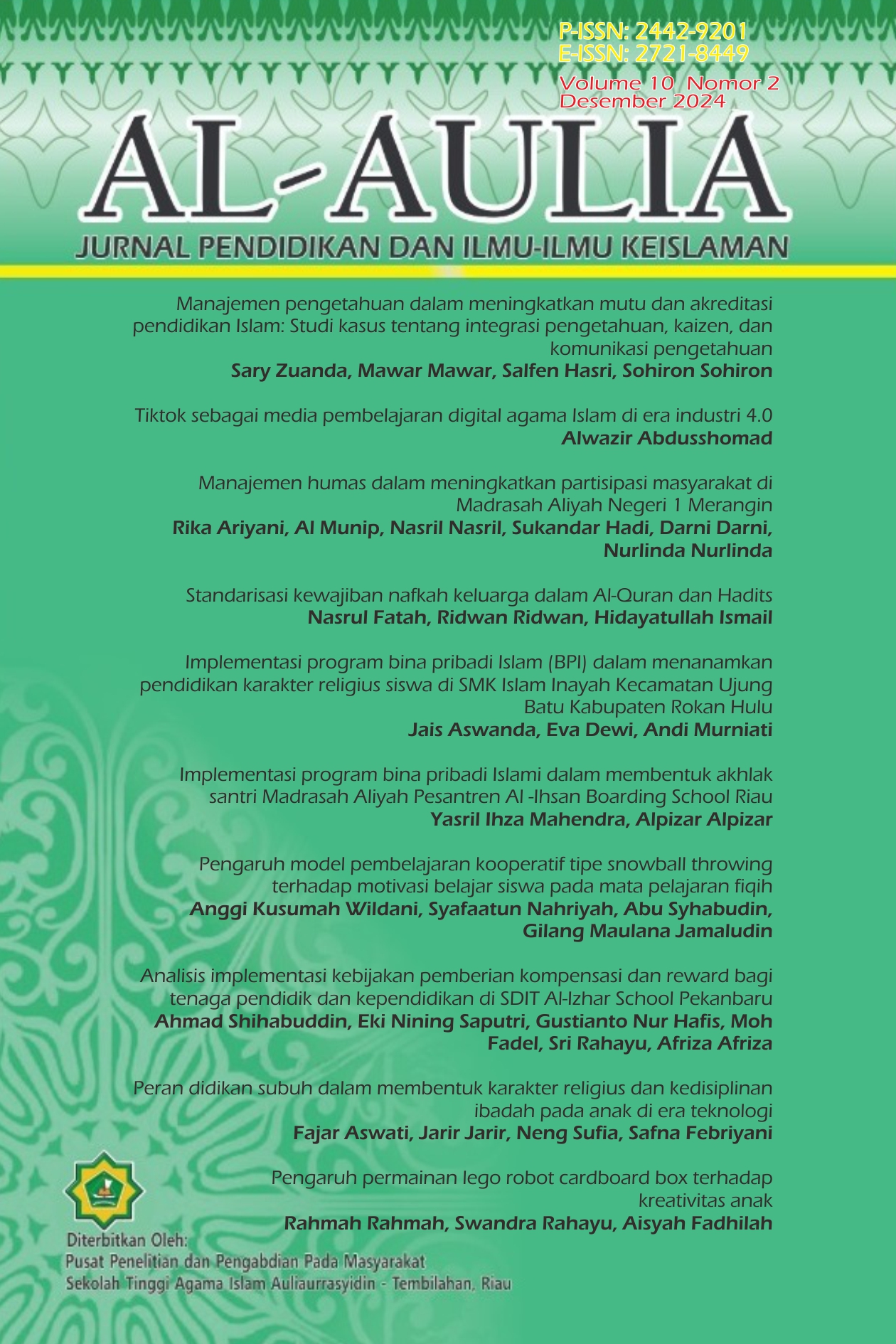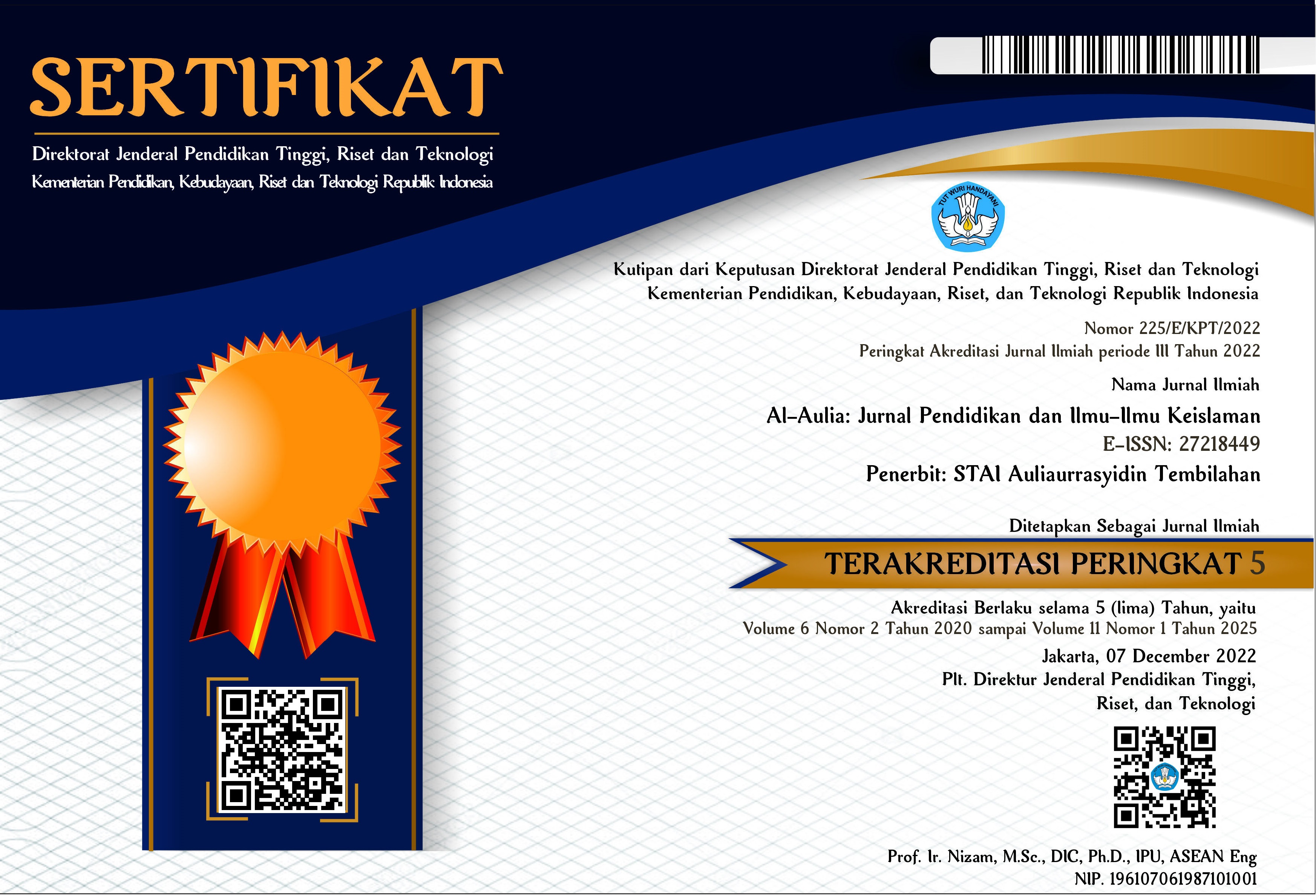Pengaruh model pembelajaran kooperatif tipe snowball throwing terhadap motivasi belajar siswa pada mata pelajaran fiqih
DOI:
https://doi.org/10.46963/aulia.v10i2.2503Keywords:
Cooperative Learning , Snowball Throwing, Learning MotivationAbstract
This research is based on the problem of student learning motivation, especially in fiqh subjects at school. This study aims to determine the effect of the application of the snowball throwing type cooperative learning model on the learning motivation of grade IX students in fiqh subjects. This type of research is quantitative research with descriptive and verifiable methods. The population in this study is all grade IX students at MTs Negeri 2 Sumedang. The sample was taken from the entire population, which was 56 students. The results of the study concluded that the average value of the snowball throwing type cooperative learning model variable of 4.02 and the student learning motivation variable of 4.11 were both in the good category. The results of data processing showed that the snowball throwing type cooperative learning model had a large and significant positive influence on students' learning motivation. This is evidenced by the figure obtained R = 0.725 with a determination coefficient of 52.5% and the remaining 47.5% influenced by other factors. Then for the hypothesis test, the results of the ttable > calculation were obtained, namely 7,731 > 2,005, therefore it means that H1 is accepted and H0 is rejected, namely there is an influence of the application of the snowball throwing type cooperative learning model on students' learning motivation.
References
Araniri, N., Nahriyah, S., Jamaludin, G. M., & Jatisunda, M. G. (2021). The impact of digital literacy ability of Islamic religious education students on FIQH learning achievements. 1st Paris Van Java International Seminar on Health, Economics, Social Science and Humanities (PVJ-ISHESSH 2020), 254–257.
dan Mudjiono, D. (2006). Study and Learning. Jakarta: Rineka Cipta.
Djalal, F. (2017). Optimalisasi pembelajaran melalui pendekatan, strategi, dan model pembelajaran. SABILARRASYAD: Jurnal Pendidikan Dan Ilmu Kependidikan, 2(1).
Hidayah, N. (2022). Pandangan terhadap problematika rendahnya mutu pendidikan di Indonesia. Jurnal Pendidikan Dan Konseling (JPDK), 4(4), 6593–6601.
Jamaludin, G. M., Araniri, N., & Nahriyah, S. (2021). MEDIA PEMBELAJARAN Pengertian, Fungsi, Tujuan, Manfaat dan Macam-Macamnya. Makeda Publika.
Jamaludin, G. M., Supriatna, D., & Burhani, A. Z. (2020). The effect of online learning system during the covid-19 pandemic on students’ learning motivation and interest in learning. Jurnal Tatsqif, 18(2), 169–182.
Juwita, E. N., & Kelana, J. B. (2021). Kemampuan Pemecahan Masalah Matematis pada Materi Pecahan Siswa SD Kelas iii Menggunakan Model Pembelajaran Snowball Throwing. COLLASE (Creative of Learning Students Elementary Education), 4(2), 187–194.
Kurniawati, F. N. A. (2022a). Meninjau permasalahan rendahnya kualitas pendidikan di indonesia dan solusi. Academy of Education Journal, 13(1), 1–13.
Kurniawati, F. N. A. (2022b). Meninjau permasalahan rendahnya kualitas pendidikan di indonesia dan solusi. Academy of Education Journal, 13(1), 1–13.
Manizar, E. (2015). Peran guru sebagai motivator dalam belajar. Tadrib, 1(2), 204–222.
Mashuri, I., Fauzi, A., & Mufidah, L. (2024). Efektivitas Model Pembelajaran Snowball Throwing terhadap Hasil Belajar Siswa pada Mata Pelajaran Aqidah Akhlak. INCARE, International Journal of Educational Resources, 5(2), 211–224.
Mirnawati, M., & Firman, F. (2019). Penerapan Teknik Clustering Dalam Mengembangkan Kemampuan Menulis Karangan Deskripsi Siswa Kelas IV MI Pesanten Datuk Sulaiman Palopo. Jurnal Studi Guru Dan Pembelajaran, 2(2), 165–177.
Mulyani, Y., Hidayat, Y., Hidayat, Y., & Yudiyanto, M. (2022). Pengaruh Penggunaan Model Pembelajaran Kooperatif Tipe Snowball Throwing Terhadap Motivasi dan Hasil Belajar Siswa. Jurnal Ilmiah Wahana Pendidikan, 8(4), 239–252.
Nur, I. M., Sari, D. P., & Jalal, A. (2024). Meningkatkan Kemampuan Berpikir Kreatif Matematika Siswa SMP melalui Model Pembelajaran Aktif Tipe Snowball Throwing. Jurnal Pendidikan MIPA, 14(4), 931–940.
Permatasari, K. G. (2021a). Problematika pembelajaran matematika di sekolah dasar/madrasah ibtidaiyah. Jurnal Pedagogy, 14(2), 68–84.
Permatasari, K. G. (2021b). Problematika pembelajaran matematika di sekolah dasar/madrasah ibtidaiyah. Jurnal Pedagogy, 14(2), 68–84.
Rahma, N., Oktaviana, N. I., Fadhilah, P. N., Apriliani, D., Mulyati, M., & Marini, A. (2023). Implementasi Model Pembelajaran Kooperatif Snowball Throwing Dalam Mata Pelajaran Ips Di Sekolah Dasar. Jurnal Pendidikan Dasar Dan Sosial Humaniora, 2(12), 1621–1632.
Rohman, A. A., & Karimah, S. (2018). Faktor-faktor yang mempengaruhi rendahnya motivasi belajar siswa kelas XI. Jurnal At-Taqaddum, 10(1), 95–108.
Safitri, A. O., Yunianti, V. D., & Rostika, D. (2022). Upaya peningkatan pendidikan berkualitas di Indonesia: Analisis pencapaian sustainable development goals (SDGs). Jurnal Basicedu, 6(4), 7096–7106.
Sugiyono, P. (2011). Metodologi penelitian kuantitatif kualitatif dan R&D. Alpabeta, Bandung, 62–70.
Suharni, S. (2021). Upaya guru dalam meningkatkan motivasi belajar siswa. G-Couns: Jurnal Bimbingan Dan Konseling, 6(1), 172–184.
Sukmayadi, T., Maarif, M., Fitri, H. R., Dewi, A. K., Merkuri, Y. G., & Haryanti, A. N. (2024). Membangun keterampilan berpikir kritis mahasiswa melalui literasi kewarganegaraan di Universitas Ahmad Dahlan. Jurnal Dimensi Pendidikan Dan Pembelajaran, 12(2), 245–256.
Yanti, H. (2019). Penerapan Model Pembelajaran Snowball Throwing Dan Media Charta Untuk Meningkatkan Hasil Belajar Pai Siswa. Jurnal Pendidikan Tambusai, 3(2), 910–917.
Downloads
Published
Issue
Section
License
Copyright (c) 2024 Anggi Kusumah Wildani, Syafaatun Nahriyah, Abu Syhabudin, Gilang Maulana Jamaludin

This work is licensed under a Creative Commons Attribution-ShareAlike 4.0 International License.
Authors who publish with this journal agree to the following terms:
1. Copyright on any article is retained by the author(s).
2. The author grants the journal, right of first publication with the work simultaneously licensed under a Creative Commons Attribution License that allows others to share the work with an acknowledgment of the work’s authorship and initial publication in this journal.
3. Authors are able to enter into separate, additional contractual arrangements for the non-exclusive distribution of the journal’s published version of the work (e.g., post it to an institutional repository or publish it in a book), with an acknowledgment of its initial publication in this journal.
4. Authors are permitted and encouraged to post their work online (e.g., in institutional repositories or on their website) prior to and during the submission process, as it can lead to productive exchanges, as well as earlier and greater citation of published work.
5. The article and any associated published material is distributed under the Creative Commons Attribution-ShareAlike 4.0 International License







